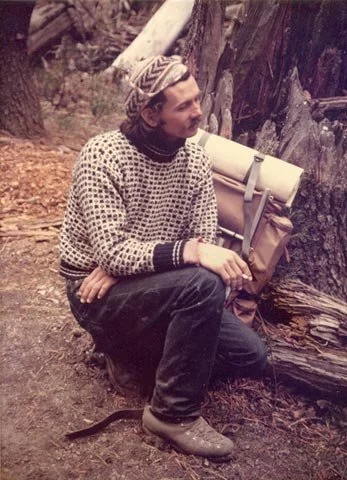John Fischer
John Fischer, early 1970s. ©2010 Spotted Dog Press
One of the 11 founding members of the American Mountain Guides Association; owner, Palisade School of Mountaineering (Bishop), John Fischer was credited with starting the first mountain medicine courses in the U.S.
John Fischer was born Friday the 13th, September 1946 in Pontiac, Illinois. By the time he was in second grade his family had moved to San Antonio, Texas, to a house within walking distance of the Alamo. After school, Fischer was soon climbing the Alamo's limestone walls, cut from local quarries and covered in moss, born of the Gulf's humidity. The Alamo's employees were so used to seeing him, that at closing time, they would call out his name knowing that he was still there, oblivious to time's passing.
By 1960 the Fischers had moved to California's Santa Clara Valley. John graduated from Pacific High School in the Santa Cruz Mountains. In the summer of 1964, at the age of 17, he hitchhiked to Alaska, where he and three other teens made the first ascent of Mount Carpathian in the Chugach Range. Too young to drive, they got a ride to the mud flats at the base of the peak. Fischer looked up at Carpathian's daunting ridges and was awed by how big it was. They roped up almost immediately and walked through the dense coastal foliage making as much noise as possible to scare off moose and grizzlies.
Fischer moved to the Haight, went to San Francisco Art Institute for a semester, then dropped out of college. He registered for the draft as a conscientious objector and, following a series of interviews to determine his authenticity, was assigned to civilian duty. In 1967 he discovered Yosemite's big walls and started climbing. He moved to the Eastern Sierra, taking up residence first at Cardinal Village, then at Fobes 40 on old Highway 395 with his first wife and their infant son.
While standing in Big Pine Canyon across from the dark granite massif of Temple Crag, John asked Dan Jensen if certain routes had ever been attempted. Jensen told him no, that the rock was too crummy. In 1969, John made the first of several first ascents on Temple Crag, climbing Sun Ribbon, one of the Celestial Aretes. In 1970, Fischer joined Mountain Travel as a guide on both domestic and international trips, working for Allen Steck, Leo LeBon, Barry Bishop and Alan Schmitz. He also guided for Mountain Travel's Palisade School of Mountaineering in Bishop, California. He was so good with clients that he was asked to be its director. At that point having only guided for two years and feeling awkward that he had been selected over an older guide, John declined and suggested Smoke Blanchard, who took the job.
In 1976, Fischer bought Palisade School of Mountaineering from Mountain Travel, operating it for the next 23 years. He guided nearly 125 international trips, 47 of those to Mexico. He made thousands of client-led ascents in the Sierra, at least 150 ascents of Mt. Sill (90 up the Swiss Arete); and 50 ascents of Mount Whitney via its technical routes.
Fischer was the first to successfully traverse the crest of the Palisade from Southfork Pass in Big Pine Canyon to the summit of Mt. Agassiz. In his 1980 account, published in the American Alpine Journal he wrote, "The Palisade, with many small glaciers and five peaks over 14,000 feet, is the most alpine region of the range. Atypical of the range in general, the mountains are precipitous on all sides and connected by narrow ridges . . . The traverse is eight miles long: a mile and a half of moderate 5th Class (editor's note: currently rated VI 5.9), some snow and mixed pitches, and acres of scrambling. The complete traverse took seven days and seven bivouacs, with approximately 12,000-feet gained and lost respectively . . . Indeed, the situation is fantastic and the quality of the climbing outstanding: the rock varies from the finest High Sierra granite to teetering stacks of shattered diorite."
The first attempt to do the traverse was in 1969, followed by several more unsuccessful attempts by other parties. Vern Clevenger and Nigel Gifford attempted the route, but aborted four days into the venture having run out of food. Fischer made three attempts before successfully completing the traverse in July, 1979. Doug Robinson accompanied Fischer on the first attempt which ended within hours of starting. Doug, who insisted on bringing his own stove, apparently never bothered to see if it was working prior to the trip. The second time Fischer attempted the traverse with Gerry Adams, one of his climbing clients, a severe electrical storm put an end to that trip. Gerry had spent a lot of time placing caches along the route, but packed them in stuff sacks instead of the plastic containers Fischer had asked him to use. Animals got into everything, dispersing the contents of each, eliminating the possibility of using the existing caches for another attempt. In between conducting mountaineering classes, Fischer spent several days climbing up to the cache locations, all above 13,000-feet, to retrieve the shredded supplies. The third time, with new caches in plastic boxes, Fischer and Adams attempted the traverse, and they were successful. For the next twenty-five years no one was able to repeat their success, though many tried.
John Fischer died June 5, 2010 doing everything he loved. He was riding his Kawasaki Concourse to meet friends, Dan Richter and Asher Waxman, for a climb of Excelsior Peak in his beloved Sierra Nevada, when a deer strayed into his path near the top of Conway Summit on US 395. In 2007, John sat down with publisher Wynne Benti and told her about his life as a mountaineering guide.
Wynne Benti, Publisher — Interview with John Fischer, May 2007.
Originally published ©2010 Spotted Dog Press, Inc.

